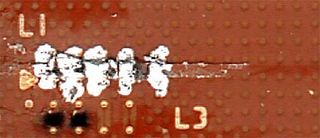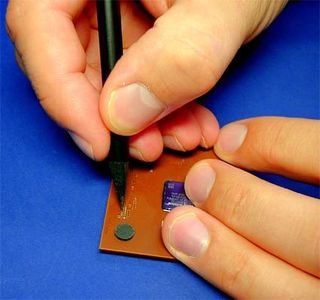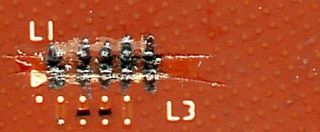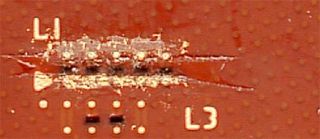Plastic Surgery: Releasing The Athlon XP To Hit 2000+
False Steps
Before finding out which method was the best, we went through a series of failed attempts in our tests. One of the main issues has to do with masking the individual contacts. Our initial attempts were made using paper, which is completely unsuitable for use with conductive silver lacquer. There's no guarantee that the CPU substrate surface has been completely covered. If you drip the lacquer into a homemade masking window made of paper, it will get underneath the paper and smear the CPU surface, and all your work will go right down the drain.

Failed attempt to mask the L1 contacts by using strips of paper.

Close-up of L1 bridges that haven't been cleanly closed. Other mistakes in the following pictures


The graphite marks made by a pencil, magnified. The resistance provided by the graphite is too high - the connections are ineffective! For the techies out there - this kind of graphite mark generally carries a contact resistance exceeding 1 k(. This level of resistance can't generate the necessary closed signal level due to the internal pull down resistance of the Athlon XP. The old Thunderbird Athlon doesn't have this pull down, which is why the classic pencil trick still works on it. If you don't mask neatly enough, you might cause the same problems that are portrayed in the images below.

In this image, the glue layer intended just for the laser locks has seeped out too far into the area where the contacts are.

Close-up of a scraped glue layer.
Stay on the Cutting Edge
Join the experts who read Tom's Hardware for the inside track on enthusiast PC tech news — and have for over 25 years. We'll send breaking news and in-depth reviews of CPUs, GPUs, AI, maker hardware and more straight to your inbox.
Current page: False Steps
Prev Page Multiplier And Voltage Settings Next Page Testing Procedures And Notes